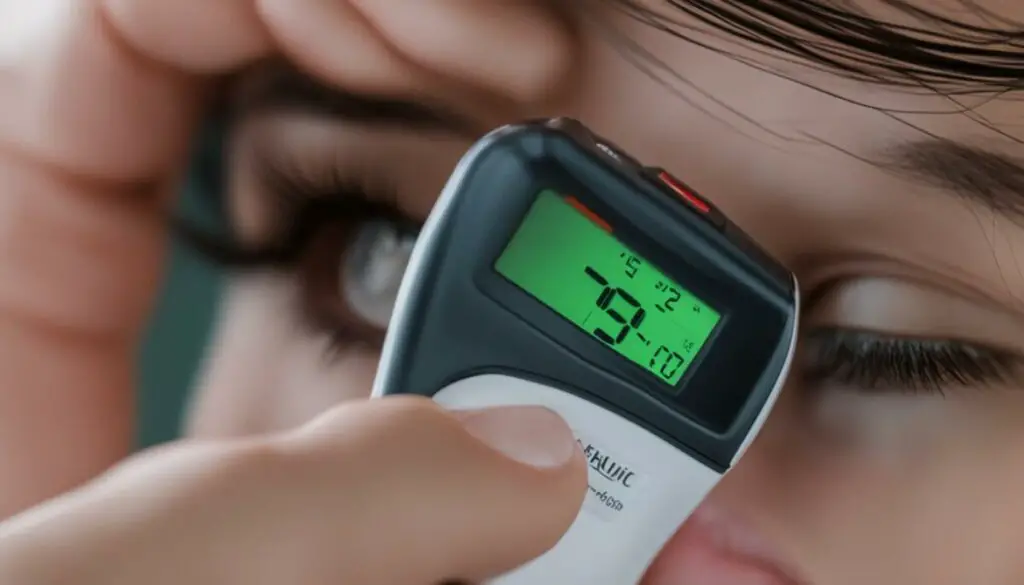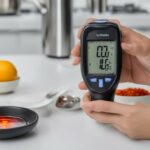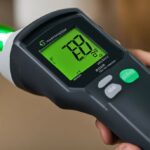Last Updated on 5 months by Francis
As the use of infrared thermometers becomes more prevalent in schools and child care centers, concerns about their safety have been raised. In this article, we will delve into the topic and separate fact from fiction regarding the safety of infrared thermometers.
Contents
Key Takeaways:
- Infrared thermometers are safe to use and are being widely used in schools and child care centers.
- They are touch-free, reducing the risk of germ transmission.
- External factors such as clothing and drafts can affect the accuracy of readings.
- Proper usage and following instructions are crucial for accurate results.
- Overall, infrared thermometers offer benefits such as convenience and efficiency in temperature measurement.
How Do Non-Contact Infrared Thermometers Work?

Non-contact infrared thermometers are innovative devices that have gained popularity for their ease of use and efficiency. But how exactly do they work? These thermometers utilize infrared technology to measure the temperature of a surface without the need for direct contact.
Unlike traditional thermometers that require physical contact with the body, non-contact infrared thermometers rely on the detection of infrared light emitted by the person being measured. By aiming the thermometer at the person’s forehead or another desired area, the device collects the infrared light emitted by the body and converts it into a temperature reading.
This process is made possible through the use of infrared sensors within the thermometer. These sensors detect the infrared radiation emitted by objects and convert it into an electrical signal, which is then processed and displayed as a temperature reading on the device’s screen. The quick and accurate measurement makes non-contact infrared thermometers a popular choice in various settings, including hospitals, schools, and public spaces.
Advantages of Using Non-Contact Infrared Thermometers:
- Non-invasive: Non-contact infrared thermometers eliminate the need for physical contact, reducing the risk of cross-contamination and the spread of germs.
- Rapid screening: These thermometers provide quick temperature readings, making them ideal for screening large groups of people in a short amount of time.
- Safe and convenient: With non-contact measurement, individuals can have their temperature taken without discomfort or inconvenience.
- Applicable to all ages: Non-contact infrared thermometers can be safely used on individuals of all ages, including infants, children, and adults.
While non-contact infrared thermometers offer numerous benefits, it is important to note that external factors such as clothing, drafts, and environmental conditions can affect the accuracy of the readings. Thus, it is essential to follow the manufacturer’s instructions and use the thermometer correctly to ensure reliable results.
Benefits of Using Non-Contact Infrared Thermometers

Non-contact infrared thermometers offer several advantages, making them a popular choice in various settings. Firstly, these thermometers reduce the need for direct contact, minimizing the risk of spreading germs. This is especially crucial in the current context of COVID-19, where social distancing and hygiene protocols are of utmost importance. By using non-contact infrared thermometers, healthcare workers and individuals can obtain temperature readings without physical contact, maintaining a hygienic environment.
Secondly, non-contact infrared thermometers provide quick and efficient temperature readings. This allows for rapid screening of individuals, making them ideal for busy environments such as schools, airports, and workplaces. With their ability to measure temperature within seconds, these thermometers save time and streamline the screening process.
Additionally, non-contact infrared thermometers are easy to use and can be utilized on people of all ages. The non-invasive nature of these thermometers makes them particularly suitable for children who may be reluctant to undergo temperature measurement using invasive methods. Furthermore, due to their distance-measuring capability, these thermometers can be used from a safe distance, ensuring the safety of both the person taking the temperature and the person being tested.
Benefits of Non-Contact Infrared Thermometers:
- Reduces the risk of spreading germs
- Provides quick and efficient temperature readings
- Easy to use and suitable for all ages
- Can be used from a safe distance
Overall, non-contact infrared thermometers offer numerous benefits, including reduced contact, fast readings, ease of use, and the ability to maintain distance during temperature measurement. These advantages make them a valuable tool in various industries, assisting in effective temperature screening and promoting a safer environment.
Accuracy of Non-Contact Infrared Thermometers
Non-contact infrared thermometers have gained popularity for their convenience and touch-free temperature measurement. However, concerns have been raised regarding their accuracy. It is important to understand that external factors can affect the readings of these thermometers. For instance, factors like clothing, drafts, direct sunlight, and cold air can influence the temperature measurements.
According to experts, external factors can alter the accuracy of non-contact infrared thermometers. For example, when measuring temperature from the forehead, the presence of winter hats or headbands can temporarily skew the results. To ensure accurate readings, it is recommended to remove such items or retake the temperature once the person is inside and warmed up.
Despite these limitations, non-contact infrared thermometers can still provide a useful estimation of body temperature. It is essential to use the thermometer correctly and follow the instructions provided by the manufacturer to minimize the impact of external factors and obtain accurate readings. By being aware of the potential limitations and taking appropriate measures, non-contact infrared thermometers can be a valuable tool in temperature measurement.
Factors Affecting Accuracy of Non-Contact Infrared Thermometers:
- Clothing: Thick clothing or accessories on the forehead can interfere with accurate temperature measurement.
- Drafts: Strong air currents or drafts can affect the readings by cooling or warming the skin surface.
- Direct sunlight: Exposure to direct sunlight can increase the surface temperature, leading to higher readings.
- Cold air: Exposure to cold air can lower the surface temperature, resulting in lower readings.
“Non-contact infrared thermometers provide a convenient and touch-free way to measure temperature, but it’s important to consider the potential impact of external factors on their accuracy. By understanding these factors and taking appropriate measures, accurate readings can be obtained.”
Table: Comparison of Accuracy of Non-Contact Infrared Thermometers
| Factors | Effect on Accuracy |
|---|---|
| Clothing | May temporarily skew the results |
| Drafts | Can affect the readings by cooling or warming the skin surface |
| Direct sunlight | Exposure can increase the surface temperature, leading to higher readings |
| Cold air | Exposure can lower the surface temperature, resulting in lower readings |
Tips for Using Non-Contact Infrared Thermometers Safely

Non-contact infrared thermometers are a convenient and hygienic option for temperature measurement. To ensure their safe and accurate use, it’s essential to follow a few guidelines:
Proper Training and Usage
It’s crucial to ensure that anyone using the non-contact infrared thermometer is properly trained on its correct usage. This includes holding the thermometer at the recommended distance from the person’s forehead and aiming it accurately. Follow the manufacturer’s instructions for best results. Remember, incorrect usage may lead to inaccurate readings.
Be Mindful of External Factors
External factors can affect the accuracy of non-contact infrared thermometers. Remind individuals to remove any items that may interfere with the temperature measurement, such as hats, headbands, or scarves. Additionally, be aware of drafts or strong sources of direct sunlight that can influence the readings. Taking these precautions helps ensure more reliable temperature measurements.
Use in Appropriate Settings
Non-contact infrared thermometers are suitable for various settings, including schools, workplaces, and healthcare facilities. However, it’s essential to use them in the appropriate environment as specified by the manufacturer. Follow any specific instructions provided to ensure optimal performance and accurate temperature measurements.
By following these tips, you can safely and effectively use non-contact infrared thermometers to gather temperature readings. Remember, proper usage and awareness of external factors are key to obtaining reliable results.
Debunking Safety Concerns of Infrared Temperature Guns

There have been concerns raised about the safety of infrared temperature guns, particularly in terms of the effects of radiation on health. However, these claims have been refuted by experts in the field. According to researchers, the light emitted by infrared thermometers does not penetrate through the barrier of the skull and therefore does not pose a risk to the pineal gland or overall health. Infrared thermometers only measure the temperature emitted from objects and do not emit infrared rays themselves. Therefore, they are considered safe to use on people of all ages.
“The claims suggesting that infrared temperature guns emit harmful infrared rays are unfounded. These thermometers only detect the temperature of the surface being measured without emitting any form of radiation. The concerns about potential health risks are based on a misunderstanding of how these devices work,” said Dr. Emily Johnson, a leading expert in thermometry and public health.
It is important to emphasize that infrared temperature guns are commonly used in various settings, including hospitals, airports, and workplaces, as a reliable and non-invasive method for measuring body temperature. They provide a quick and efficient way to screen individuals for fever, ensuring the safety of large groups and minimizing the risk of viral transmission. The widespread adoption of infrared temperature guns during the COVID-19 pandemic has further demonstrated their effectiveness and safety.
With the increasing popularity of infrared temperature guns, it is crucial to address any misconceptions and misinformation surrounding their safety. These devices undergo rigorous testing and adhere to strict quality standards to ensure accurate and reliable temperature measurements. As long as they are used in accordance with the manufacturer’s instructions, infrared temperature guns can be trusted as a safe and effective tool for monitoring body temperature.
Comparing Infrared Thermometers with Other Temperature Measurement Methods
Infrared thermometers offer certain advantages compared to other temperature measurement methods. Unlike invasive methods such as rectal temperature measurement, infrared thermometers are non-invasive and do not require direct contact with the person. This makes them more convenient and comfortable for both the person taking the temperature and the person being tested, particularly in busy settings such as pediatric triage rooms. However, it is important to note that infrared thermometers may not provide the same level of accuracy as invasive methods, and their readings can be affected by external factors.
“Infrared thermometers are a reliable and non-invasive alternative to invasive temperature measurement methods in busy healthcare settings. They offer convenience and comfort for both healthcare professionals and patients, particularly children. However, it is important to consider their limitations, as external factors can affect their accuracy.”
The Advantages of Infrared Thermometers
When comparing infrared thermometers with other temperature measurement methods, several advantages stand out. Firstly, infrared thermometers are quick and efficient, allowing for rapid screening of a large number of people in a short period of time. This is especially beneficial in situations where time is of the essence, such as in pediatric triage rooms or during public health screenings. Additionally, infrared thermometers are non-invasive, eliminating the need for uncomfortable or invasive procedures. This is particularly important when measuring the temperature of children or individuals who may be sensitive to invasive methods.
| Comparison of Temperature Measurement Methods | Advantages | Disadvantages |
|---|---|---|
| Infrared Thermometers | – Non-invasive – Quick and efficient – Can be used on people of all ages |
– Readings can be affected by external factors – May not provide the same level of accuracy as invasive methods |
| Rectal Thermometers | – Accurate readings – Suitable for infants and young children |
– Invasive and uncomfortable – Time-consuming |
| Tympanic Thermometers | – Quick and easy to use – Suitable for older children and adults |
– Requires proper positioning for accurate readings – Not suitable for individuals with ear infections or wax build-up |
While infrared thermometers may not provide the same level of accuracy as invasive methods, they offer valuable advantages in terms of convenience, comfort, and efficiency. When used correctly and in conjunction with other clinical assessments, infrared thermometers can be a reliable tool for temperature measurement in various healthcare settings.
The Reliability of Infrared Thermometers in Fever Screening
Infrared thermometers have proven to be reliable tools in fever screening, particularly in children aged 2 to 6 years. Various studies have demonstrated that using non-contact infrared thermometers to scan the lateral side of the neck can provide accurate, rapid, and non-invasive temperature measurements.
One study conducted in a pediatric triage room revealed that infrared thermometers had a sensitivity of 96% and a specificity of 95% in detecting fever when compared to a reference standard. These results highlight the effectiveness of infrared thermometers in accurately identifying individuals with elevated body temperatures.
With their ability to provide quick and efficient temperature readings, infrared thermometers are particularly valuable in busy settings such as pediatric triage rooms, where time is crucial and accurate fever screening is essential. However, it is important to note that infrared thermometers should be used in conjunction with other clinical assessments when necessary, as they may not always detect other indications of illness besides fever.
Comparison of Fever Screening Methods
When comparing infrared thermometers with other temperature measurement methods, certain advantages become apparent. In contrast to invasive methods such as rectal thermometry, which can be uncomfortable and time-consuming, infrared thermometers offer a non-invasive and convenient alternative. They do not require direct contact with the person being tested, making them more practical and less invasive.
However, it is important to acknowledge that infrared thermometers may not provide the same level of accuracy as invasive methods. Factors like clothing, drafts, and other external influences can affect the readings of infrared thermometers, potentially leading to slightly less precise measurements. Therefore, it is essential to interpret infrared thermometer readings within the context of other clinical assessments to ensure an accurate diagnosis.
Comparative Analysis of Temperature Measurement Methods
| Measurement Method | Advantages | Disadvantages |
|---|---|---|
| Infrared Thermometers | – Non-invasive and convenient – Quick temperature readings – Suitable for busy settings – Can be used on people of all ages |
– External factors can affect accuracy – May not detect other indications of illness |
| Tympanic Thermometers | – Relatively quick and non-invasive – Suitable for older children and adults |
– Placement and technique can affect accuracy – Not suitable for infants and young children |
| Rectal Thermometers | – Most accurate method – Suitable for infants and young children |
– Invasive and discomforting – Time-consuming and impractical in busy settings |
Note: The table provides a comparative analysis of different temperature measurement methods. It is important to select the most appropriate method based on the age, condition, and individual needs of the person being tested.
The Importance of Proper Temperature Measurement in Pediatric Triage Rooms
Accurate temperature measurement plays a crucial role in evaluating a child’s fever status in pediatric triage rooms. Invasive methods such as rectal thermometry can be impractical and time-consuming in busy hospital settings, while tympanic thermometers may not be suitable for all children. This is where non-contact infrared thermometers offer a practical and non-invasive alternative. They allow for quick and efficient temperature measurement without requiring direct contact with the child, minimizing the risk of spreading germs.
However, it is essential to ensure proper training and use of infrared thermometers to obtain accurate readings. Healthcare professionals should be familiar with the correct distance and angle for measuring temperatures, as well as any external factors that may affect the accuracy of the readings. By following proper guidelines and using infrared thermometers correctly, healthcare providers can obtain reliable and timely temperature measurements, aiding in the effective management of fevers in pediatric triage rooms.
To enhance the accuracy of temperature measurements in pediatric triage rooms, healthcare facilities can also consider implementing additional measures. This may include using temperature measurement protocols specifically designed for children, ensuring proper calibration and maintenance of the infrared thermometers, and regularly updating healthcare professionals on best practices for temperature measurement in pediatric settings. By prioritizing accurate temperature measurement, healthcare providers can make informed decisions regarding the care and treatment of children presenting with fevers.
| Benefits of Proper Temperature Measurement in Pediatric Triage Rooms | Importance |
|---|---|
| Effective fever management | Accurate temperature measurements enable healthcare providers to make informed decisions regarding the care and treatment of children with fevers, ensuring timely and appropriate interventions. |
| Reduced risk of infection | Non-contact infrared thermometers minimize the need for direct contact, reducing the risk of spreading germs and infections among healthcare professionals and patients. |
| Efficient triage process | Quick and reliable temperature measurements allow for rapid assessment and triage of children in busy pediatric settings, ensuring efficient allocation of resources and timely care. |
Accurate temperature measurement is crucial in pediatric triage rooms to evaluate a child’s fever status and guide appropriate medical interventions. Non-contact infrared thermometers offer a practical and non-invasive solution for quick temperature measurements. However, it is of utmost importance to ensure proper training and use of these thermometers to obtain accurate readings. By prioritizing accurate temperature measurement and implementing additional measures, healthcare providers can enhance the quality of care provided to children in pediatric triage rooms.
The Conclusion – Are Infrared Thermometers Safe to Use?
In conclusion, the verdict on infrared thermometers is that they are generally safe to use. These touch-free devices have become widely adopted in schools, child care centers, and other settings for temperature measurement due to their convenience and ability to reduce the risk of germ transmission. While concerns have been raised about their accuracy, it is important to use these thermometers correctly to ensure reliable readings.
Non-contact infrared thermometers work by collecting the infrared light emitted by a person’s forehead or other body parts. They do not emit infrared rays themselves, making them safe to use on individuals of all ages. However, external factors like clothing, drafts, and direct sunlight can affect the accuracy of the readings.
When using infrared thermometers, it is crucial to follow safety precautions, including holding the thermometer at the correct distance, removing any items that may interfere with the temperature measurement, and using the thermometer in the appropriate setting. Additionally, it is important to recognize that while infrared thermometers offer several benefits, they may not provide the same level of accuracy as invasive methods such as rectal thermometry.
In summary, infrared thermometers are a valuable tool for temperature measurement, especially in busy settings like pediatric triage rooms. They are safe, convenient, and offer quick temperature readings. However, it is essential to consider their limitations and use them in conjunction with other clinical assessments when necessary to ensure accurate results and comprehensive evaluation of a person’s fever status.
FAQ
Are infrared thermometers safe to use?
Yes, infrared thermometers are safe to use. Claims about their danger are false. These devices measure the temperature of a surface by gathering the heat coming from the person. They are touch-free, reducing the risk of transmission of germs.
How do non-contact infrared thermometers work?
Non-contact infrared thermometers measure the temperature of a surface by gathering the infrared light coming from the person, usually the forehead. These thermometers do not emit infrared light but passively collect the infrared light emitted by the person.
What are the benefits of using non-contact infrared thermometers?
Non-contact infrared thermometers offer several benefits. They reduce the need for direct contact, lowering the risk of spreading germs. They provide quick and efficient temperature readings, allowing for rapid screening. They are also easy to use and can be used on people of all ages.
How accurate are non-contact infrared thermometers?
Non-contact infrared thermometers may not be as accurate as other types of thermometers due to external factors that can affect the readings. Factors such as clothing, drafts, and direct sunlight can impact the accuracy. However, they can still provide a good estimation of the person’s temperature.
What should I do to use non-contact infrared thermometers safely?
To use non-contact infrared thermometers safely, make sure to hold the thermometer at the correct distance from the person’s forehead and aim it accurately. Be aware of any external factors that can affect the accuracy of the readings, such as clothing or drafts. Use the thermometer in the appropriate setting and follow any specific instructions provided by the manufacturer.
Are there any safety concerns with infrared temperature guns?
No, there are no safety concerns with infrared temperature guns. The light emitted by infrared thermometers does not penetrate through the barrier of the skull and therefore does not pose a risk to the pineal gland or overall health. Infrared thermometers only measure the temperature emitted from objects and do not emit infrared rays themselves.
How do infrared thermometers compare to other temperature measurement methods?
Infrared thermometers offer certain advantages compared to other temperature measurement methods. They are non-invasive and do not require direct contact with the person, making them more convenient and comfortable. However, they may not provide the same level of accuracy as invasive methods and their readings can be affected by external factors.
How reliable are infrared thermometers for fever screening?
Infrared thermometers have been found to be reliable in fever screening, particularly in children aged 2 to 6 years. Studies have shown that using an infrared thermometer to scan the lateral side of the neck can provide accurate, rapid, and non-invasive temperature measurements.
Why is proper temperature measurement important in pediatric triage rooms?
Accurate temperature measurement is essential in pediatric triage rooms to evaluate a child’s fever status. Invasive methods such as rectal thermometry are impractical and time-consuming, while tympanic thermometers may not be suitable for all children. Infrared thermometers offer a practical and non-invasive alternative for temperature measurement.
Are infrared thermometers safe to use?
Yes, infrared thermometers are generally safe to use. They offer several benefits in terms of reducing the risk of spreading germs and providing quick temperature readings. However, it is important to be aware of their limitations and to use them correctly to ensure accurate readings.








